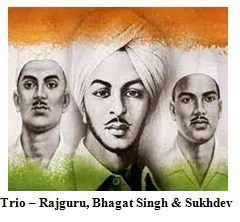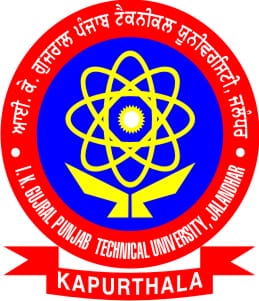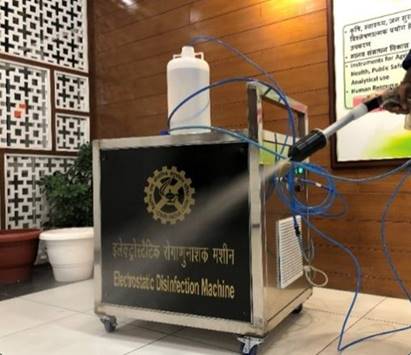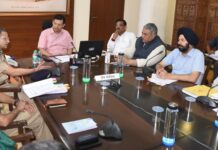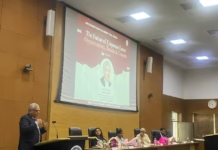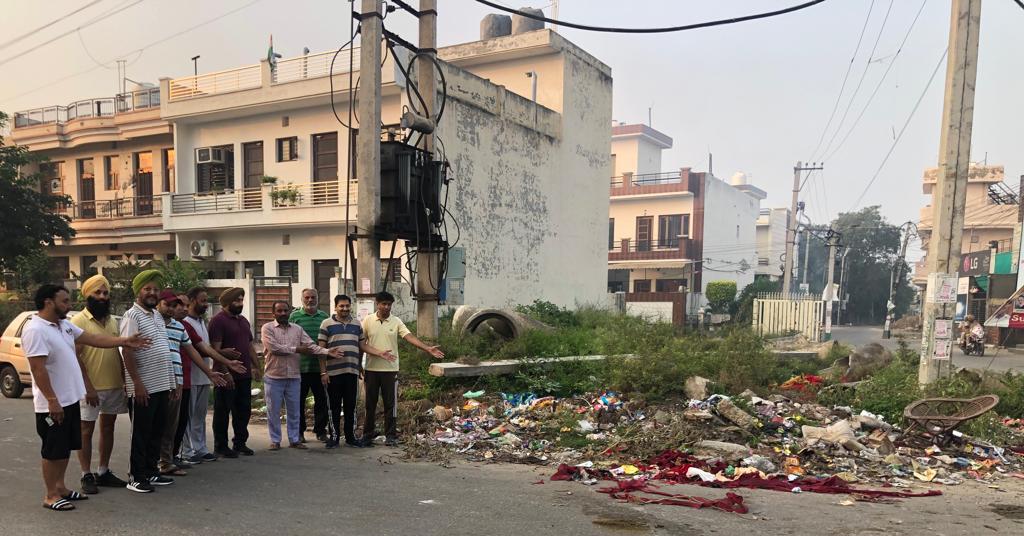Let’s pay our tributes to symbol of patriotism Bhagat Singh, Rajguru, Sukhdev on their martyrdom day-Puri
Jaswant Singh Puri/ March 23,2023
Homage’s are paid on Martyrs’ Day (23rd March) every year to honour the gallant and brave Indian people who sacrificed their lives to save the Motherland. 23rd March will always remain etched in our memory, since on this day in 1931, three brave and extraordinary revolutionary leaders – Bhagat Singh, Shivram Rajguru and Sukhdev Thapar were hanged by the Britishers. They were hanged to death in Lahore Jail for their involvement and assassinating a 21 year old Police Officer John Saundres in 1928 when they mistook him for James Scott, a British Police Superintendent. They took this adventurous step as an act of revenge against James Scott for ordering a lathi charge that caused Lala Lajpat Rai’s death.
Revolutionary nationalists such as Bhagat Singh and his comrades wanted to fight against communal rule through revolution to achieve freedom of India. They founded the Hindustan Socialist Republican Association (HSRA) in 1928 at Ferozeshah Kotla in Delhi. Bhagat Singh along with his fellow nationalist B.K. Dutt also threw a bomb in the Central Legislative Assembly on 8th April, 1929. The purpose of this bomb-throwing was not to kill anyone but “to make the deaf hear” and to remind the British Rulers of their cold and callous exploitation.

The brave heroes – Bhagat Singh, Shivram Rajguru and Sukhdev Thapar sacrificed their lives on March 23, 1931 to free India from the shackles of the British Rulers. Bhagat Singh is often referred to as ‘Shaheed’ Bhagat Singh, the word ‘Shaheed’ meaning ‘martyr’. While in jail, Bhagat Singh joined educationist and freedom fighter Jatin Das’s hunger-strike movement and demanded better prison conditions for Indian prisoners. Jatin Das left this world in the jail in September, 1929 due to starvation.
Bhagat Singh was born on September 28, 1907 in Lyallpur, Western Punjab, India (now in Pakistan). His father’s name was Kishan Singh, member of Ghadar Party and mother was Vidyavati Kaur. Sukhdev was born on May 15, 1907 in Ludhiana’s Naughara Mohalla to Ram Lal Thapar and Ralli Devi.
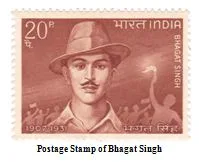
Bhagat Singh’s ancestral home is located in Khatkar Kalan in Nawanshahar district of Punjab. Bhagat Singh got his education from Dayanand Anglo-Vedic High School and then National College, both located in Lahore. National College was founded by Lala Lajpat Rai in response to Mahatma Gandhi’s non-cooperation movement. Bhagat Singh began to protest against the British rule in India at a young age. He wrote for Kirti, the journal of the Kirti-Kisan Party. He also contributed to Veer Arjun newspaper, published in Delhi. He used pseudonyms like Balwant, Ranjit and Vidhrohi to hide his identity.
In 1929, the HSRA had set up bomb factories in Lahore and Saharanpur but the Lahore bomb factory was discovered by the police, leading to the arrest of members of HSRA, including Sukhdev, Kishori Lal and Jai Gopal. Soon, the Saharanpur factory was also raided as some of the conspirators became police informers. Now, the police was able to connect the angles of Saunders’ murder, assembly bombing and bomb factory events. Bhagat Singh, Sukhdev, Rajguru and 21 others were charged with the murder of Saunders. A plan to save Bhagat Singh and fellow HSRA inmates from the jail failed. HSRA member Durga Devi’s husband, Bhagwati Charan Vohra, attempted to manufacture bombs but died when these exploded accidentally.
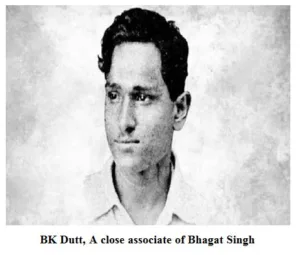
Rajguru was born on August 24, 1908 in a middle-class Deshastha Brahmin family at Khed in Pune district. The trio Bhagat Singh, Rajguru and Sukhdev grew up witnessing the injustice and exploitation of the British Regime. We remember the highly inspiring and devotional verses by Ram Prasad Bismil which convey immense patriotism:
“Sarfaroshi ki tamanna ab hamare dil mein hai,
Dekhna hai zor kitna baazu-e-quatil mein hai….”
Bhagat Singh, Rajguru and Sukhdev were sentenced to death in the Lahore Conspiracy Case and ordered to be hanged on 24th March, 1931. However, they were hanged on 23rd March, 1931 at 07:30 pm. The jail authorities then removed the three bodies surreptitiously and cremated them outside Ganda Singh Wala village. Their ashes were thrown into the Sutlej River, about ten kilometers from Ferozepur.
The executions were reported widely by the press. Strikes and processions for mourning were called. Gandhi wrote in the issue of Young India of 29th March, 1931: “Bhagat Singh and his two associates have been hanged. The Congress made many attempts to save their lives and the Government entertained many hopes of it, but all has been in vain.”
Bhagat Singh was not a devotee of non-violence but he did not subscribe to the religion of violence. He took to violence as the last resort to defend his motherland. In his last letter, Bhagat Singh wrote: “I have been arrested while waging a war. For me there can be no gallows. Put me into the mouth of cannon and blow me off”. The three heroes – Bhagat Singh, Sukhdev and Rajguru had conquered the fear of death.
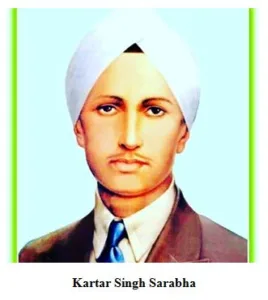
Bhagat Singh regarded Kartar Singh Sarabha, the founder of the Ghadar Party as his hero. Bhai Parmanand was also his motivational force. Subhash Chandra Bose said: “Bhagat Singh had become the symbol of the new awakening among the youths”. Nehru said: “Bhagat Singh was like a spark that became a flame in a short time”. The National Martyrs Memorial was built at Hussainiwala, District Ferozepur in memory of Bhagat Singh, Sukhdev and Rajguru in 1968. The Bhagat Singh Memorial was built in 2009 in Khatkar Kalan in 2009. A group of intellectuals set up an institution named Bhagat Singh Sansthan to commemorate him and his ideals. Several films have been made portraying Bhagat Singh’s life and times.
The song ‘Mera Rang de Basanti Chola’ is associated with Bhagat Singh and his associates. A postage stamp in 1968 was issued in India on Bhagat Singh’s 61st birth anniversary. Bhagat Singh wrote the books “Why I am an Atheist”, “Ideas on Freedom, Liberty and Revolution: Jail Notes of a Revolutionary”, “Jail Diaries and Other Writings”, “Ideas of a Nation”, “Bhagat Singh Ke Siyasi Dastavez” etc. To remember his sacrifices, the airport at Chandigarh has been named Bhagat Singh International Airport, Chandigarh. Rajguru’s birthplace of Khed was renamed as Rajguru Nagar in his honour. The ancestral house of Rajguru on Pune-Nashik Road is being maintained as a memorial to honour Shivram Rajguru. Shaheed Rajguru College of Applied Sciences for Women is located in Vasundhara Enclave, New Delhi. Shaheed Sukhdev College of Business Studies was established in August, 1987 in memory of Sukhdev. It is a constituent college of Delhi University. Amar Shaheed Sukhdev Thapar Interstate Bus Terminal is the main bus stand of Ludhiana.

The martyrdom of the trio – Bhagat Singh, Rajguru and Sukhdev inspires us all for patriotism even today. We are breathing in free India by virtue of sacrifices of great revolutionaries and fighters. I also recollect the oft quoted famous lines:
“Shaheedo ki chitaon par lagenge har baras mele,
Watan par marne walon ka yahi baaki nishan hoga”.

Note: This article is dedicated to Smt. Alka Puri wife of Dr. Ajit Singh Puri and mother of Jaswant Singh Puri.
(The views expressed are personal)

